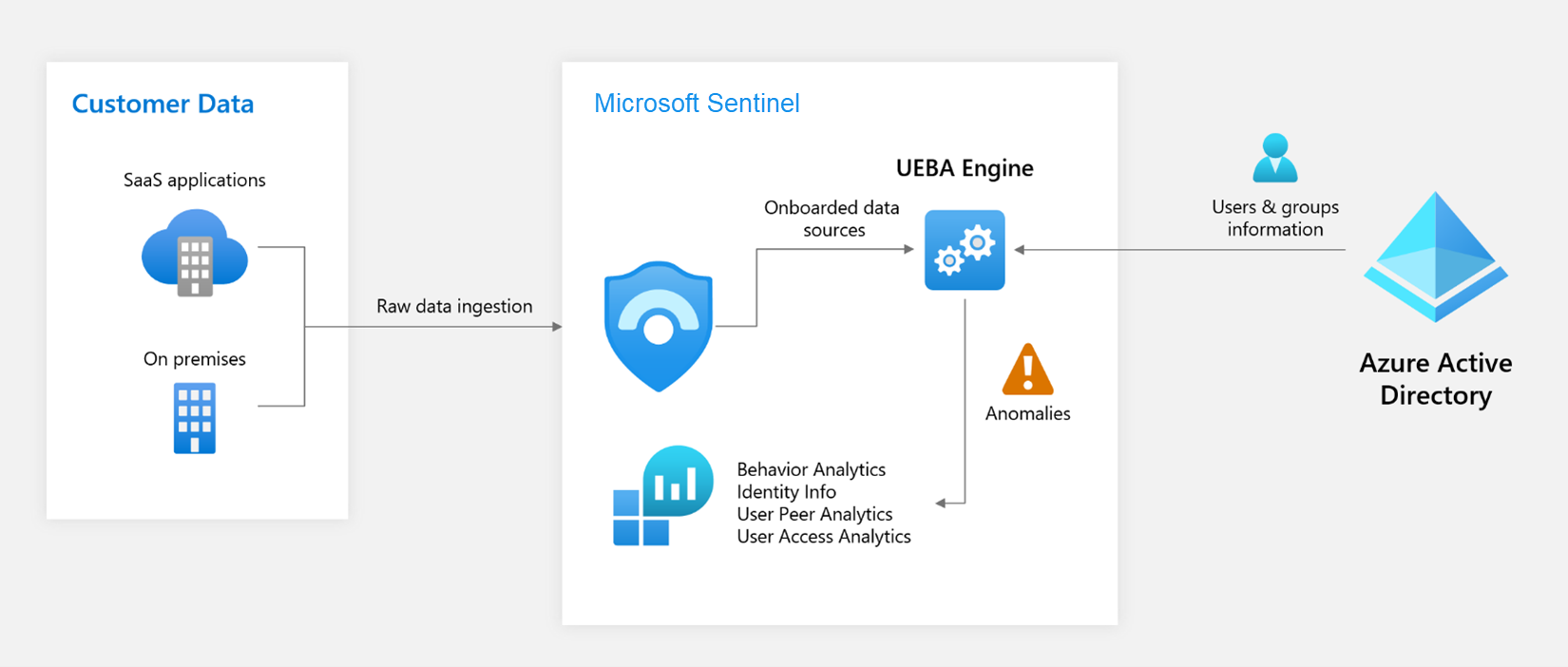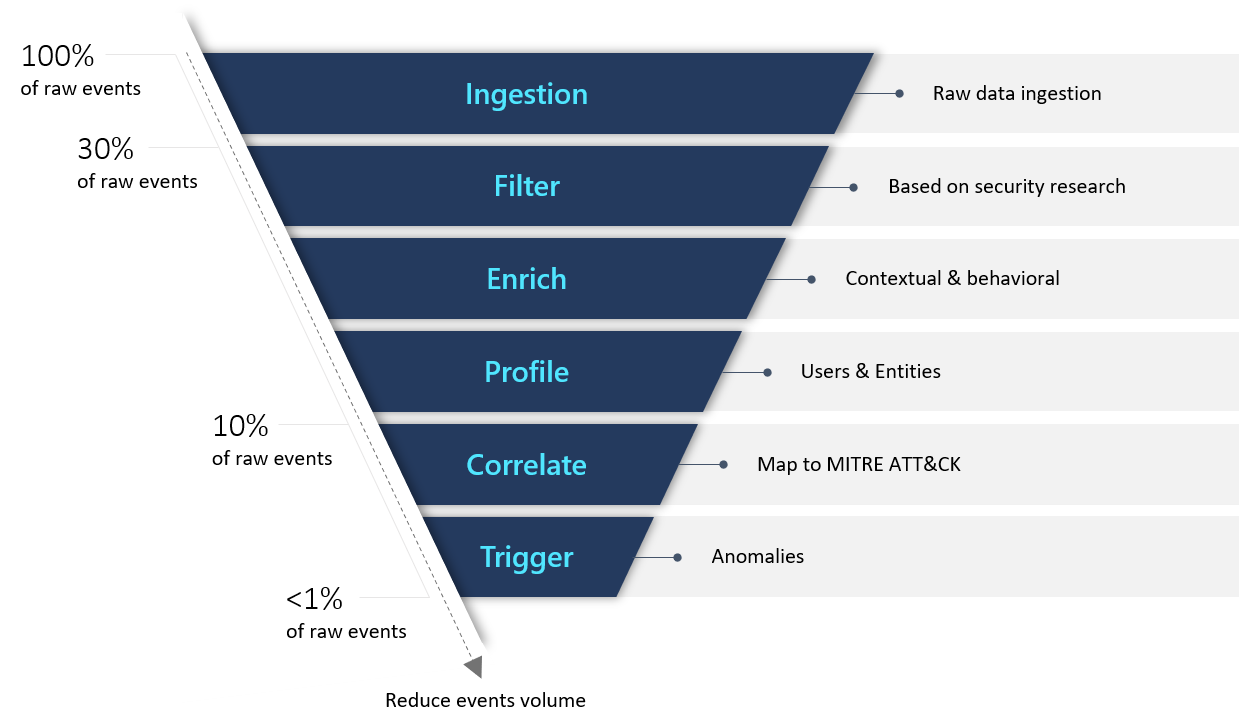Note
Access to this page requires authorization. You can try signing in or changing directories.
Access to this page requires authorization. You can try changing directories.
Important
Attention: All Microsoft Sentinel features will be officially retired in Azure in China regions on August 18, 2026 per the announcement posted by 21Vianet.
Detecting anomalous behavior inside your organization is complex and slow. Microsoft Sentinel User and Entity Behavior Analytics (UEBA) streamlines anomaly detection and investigation by using machine learning models to build dynamic baselines and peer comparisons for your tenant. Instead of just collecting logs, UEBA learns from your data to surface actionable intelligence that helps analysts detect and investigate anomalies.
This article explains how Microsoft Sentinel UEBA works and how to use UEBA to surface and investigate anomalies and enhance your threat detection capabilities.
What is UEBA?
As Microsoft Sentinel collects logs and alerts from all of your connected data sources, UEBA uses artificial intelligence (AI) to build baseline behavioral profiles of your organization's entities - such as users, hosts, IP addresses, and applications - over time and across peer groups. UEBA then identifies anomalous activity and helps you determine whether an asset is compromised.
UEBA also determines the relative sensitivity of particular assets, identifies peer groups of assets, and evaluates the potential impact of any given compromised asset - its “blast radius”. This information lets you prioritize your investigation, hunting, and incident handling effectively.
UEBA analytics architecture

Security-driven analytics
Inspired by Gartner's paradigm for UEBA solutions, Microsoft Sentinel provides an "outside-in" approach, based on three frames of reference:
Use cases: By prioritizing for relevant attack vectors and scenarios based on security research aligned with the MITRE ATT&CK framework of tactics, techniques, and subtechniques that puts various entities as victims, perpetrators, or pivot points in the kill chain; Microsoft Sentinel focuses specifically on the most valuable logs each data source can provide.
Data sources: While first and foremost supporting Azure data sources, Microsoft Sentinel thoughtfully selects third-party data sources to provide data that matches our threat scenarios.
Analytics: Using various machine learning (ML) algorithms, Microsoft Sentinel identifies anomalous activities and presents evidence clearly and concisely in the form of contextual enrichments, some examples of which appear below.

Microsoft Sentinel presents artifacts that help your security analysts get a clear understanding of anomalous activities in context, and in comparison with the user's baseline profile. Actions performed by a user (or a host, or an address) are evaluated contextually, where a "true" outcome indicates an identified anomaly:
- across geographical locations, devices, and environments.
- across time and frequency horizons (compared to user's own history).
- as compared to peers' behavior.
- as compared to organization's behavior.

The user entity information that Microsoft Sentinel uses to build its user profiles comes from your Microsoft Entra ID (and/or your on-premises Active Directory, now in Preview). When you enable UEBA, it synchronizes your Microsoft Entra ID with Microsoft Sentinel, storing the information in an internal database visible through the IdentityInfo table.
See Enable User and Entity Behavior Analytics (UEBA) in Microsoft Sentinel to learn how to enable UEBA and synchronize user identities.
Scoring
Each activity is scored with "Investigation Priority Score" – which determine the probability of a specific user performing a specific activity, based on behavioral learning of the user and their peers. Activities identified as the most abnormal receive the highest scores (on a scale of 0-10).
Learn more about entities in Microsoft Sentinel and see the full list of supported entities and identifiers.
Entity pages
Information about entity pages can now be found at Entity pages in Microsoft Sentinel.
Querying behavior analytics data
Using KQL, we can query the BehaviorAnalytics table.
For example – if we want to find all the cases of a user that failed to sign in to an Azure resource, where it was the user's first attempt to connect from a given country/region, and connections from that country/region are uncommon even for the user's peers, we can use the following query:
BehaviorAnalytics
| where ActivityType == "FailedLogOn"
| where ActivityInsights.FirstTimeUserConnectedFromCountry == True
| where ActivityInsights.CountryUncommonlyConnectedFromAmongPeers == True
User peers metadata - table and notebook
User peers' metadata provides important context in threat detections, in investigating an incident, and in hunting for a potential threat. Security analysts can observe the normal activities of users` peers to determine whether a user's activities are unusual as compared to those of their peers.
Microsoft Sentinel calculates and ranks a user's peers, based on the user's Microsoft Entra security group membership, mailing list, et cetera, and stores the peers ranked 1-20 in the UserPeerAnalytics table. The screenshot below shows the schema of the UserPeerAnalytics table, and displays the top eight-ranked peers of the user Kendall Collins. Microsoft Sentinel uses the term frequency-inverse document frequency (TF-IDF) algorithm to normalize the weighing for calculating the rank: the smaller the group, the higher the weight.
You can use the Jupyter notebook provided in the Microsoft Sentinel GitHub repository to visualize the user peers metadata. For detailed instructions on how to use the notebook, see the Guided Analysis - User Security Metadata notebook.
Note
The UserAccessAnalytics table has been deprecated.
Hunting queries and exploration queries
Microsoft Sentinel provides out-of-the-box a set of hunting queries, exploration queries, and the User and Entity Behavior Analytics workbook, which is based on the BehaviorAnalytics table. These tools present enriched data, focused on specific use cases, that indicate anomalous behavior.
For more information, see:
As legacy defense tools become obsolete, organizations may have such a vast and porous digital estate that it becomes unmanageable to obtain a comprehensive picture of the risk and posture their environment may be facing. Relying heavily on reactive efforts, such as analytics and rules, enable bad actors to learn how to evade those efforts. This is where UEBA comes to play, by providing risk scoring methodologies and algorithms to figure out what is really happening.
Next steps
In this document, you learned about Microsoft Sentinel's entity behavior analytics capabilities. For practical guidance on implementation, and to use the insights you've gained, see the following articles:
- Enable entity behavior analytics in Microsoft Sentinel.
- Investigate incidents with UEBA data.
- Hunt for security threats.
For more information, also see the Microsoft Sentinel UEBA reference.
